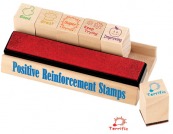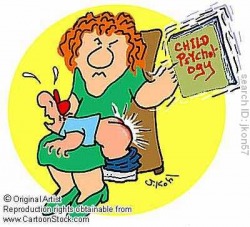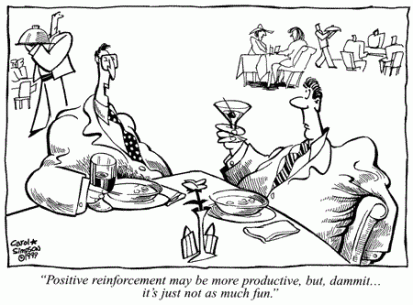Punishment and Reinforcement in General
In order to explain his theory of operant conditioning, Skinner defined two main terms: reinforcement and punishment. Reinforcement is simply defined as "the effect of a reinforcer"(Lefrancois, 2006). A reinforcer is "an event that follows a response and that changes the probability of a response's occurring again" (Lefrancois). Additionally, reinforcers are defined by observable and measureable behaviors. Reinforcement can then be broken down into positive and negative reinforcement. Positive reinforcement occurs "when the consequences of the behavior, when added to a situation after a response, increase the probability of the response's occurring again in similar conditions" (Lefrancois). An example of this would be a reward. Negative reinforcement on the other hand, occurs "when the probability of a response's occurring increases as a function of something being taken away from a situation" (Lefrancois). An example of this would be similar to the feeling of relief.
Punishment is similar to reinforcement in that both are defined by its effects. The main difference between the two, however, is that the effect of punishment involves the suppression of a behavior rather that the strengthening of it as in reinforcement (Lefrancois, 2006). Punishment also has two types, positive and negative. Positive punishment is "when a positive contingency is removed"(Lefrancois). An example of this could be a penalty. It is also known as removal punishment. Negative punishment is "when a negative contingency follows a behavior" (Lefrancois). This is what most people commonly think of when they think of the term punishment and is sometimes referred to as presentation punishment. An example could be the spanking of a child after misbehaving.
Schools' Use of Punishment and Reinforcement

As Skinner described in his theory of operant conditioning, punishment and reinforcement can be used in a variety of settings including at home and even at school. Skinner relates a classroom to a giant Skinner box. He said that teachers could profit from knowing that reinforcement is effective in helping to elicit changes in behavior (Lefrancois, 2006). He said that there are five categories of reinforcers: consumables such as food or candy, manipulatables such as toys or trinkets, visual and auditory stimuli such as a bell signal that means “good work”, social stimuli such as praise, and tokens such as disks that can be exchanged for other reinforcers (Lefrancois). All of these things increase the probability that a response will occur again. He continues by saying that punishment is not very effective for learning (Lefrancois).
Punishment (Traditionally Used)
- Involves the presentation of an unpleasant stimulus or the withdrawal of a pleasant stimulus as a consequence of behavior
- Decreases the probability that a behavior will occur.
E.g.) removals from the classroom, fines, suspensions, expulsions, etc.
Reinforcement
- Involves the presentation of a pleasant stimulus or the withdrawal of an unpleasant stimulus as a consequence of behavior.
- Increases the probability that a response will occur.
E.g.) praise, tokens, rewards, etc.
Punishment in Schools
The exhibition of problem behaviors in students is something that has become a major concern in recent years in schools across the country. However, this pressing matter has been around for decades, during which time, many teachers have struggled to find the best way to deal with such issues. Traditionally, schools have employed more punishment-based practices such as removals from the classroom, fines, suspensions, and expulsions (Maag, 2001). Maag tells us that the use of such practices may help make schools safer by removing those children who exhibit the most severe problem behaviors; however, these measures do little to help instill skills in children to learn the appropriate ways to behave. Kohn (1996) also explains that making students do what teachers tell them to do and simply managing their behavior does not promote community or compassion, responsibility or reflection, some key items that are helpful in preventing these problem behaviors in the future.
Many educators often prefer punishment for various reasons including the fact that punishment is often easy to administer, can be used for all types of students and problem behaviors, and has been widely used for centuries (Maag, 2001). Additionally, inappropriate behaviors are often believed to cease immediately after the applied punishment. However, this cessation is oftentimes only temporary (Maag, 1999). Additionally, these students are often the ones with the most serious behavior problems (Maag, 2001). Atkins (2002) also confirms that students who show the highest frequency of behavioral problems not only maintain their problems throughout the entire time they are in school, but are also those who receive the most discipline, and have academic and behavioral deficits. It has also been shown that the most severely disciplined children often have grades that are well below average and are the most likely to be involved in gangs.

Atkins (2002) also found results in their study that showed that for students whose rates of disruptive behavior increased over the school year, using detentions and suspensions actually proved to be an inappropriate and ineffective use of punishment. This confirmed the idea that punishment alone is not effective in ameliorating the most severe offenses and does little to reeducate those who most frequently display problem behaviors. Although punishment has had some success in temporarily ameliorating problem behaviors, they have more often been shown to cause more harm than good. Punishing practices may actually increase the severity of the very problem behaviors that they are trying to reduce. As violence and disruptive behavioral problems have increased in schools over the past few years, schools have been forced to develop new strategies in order to deal with these problem behaviors. It has since been realized that in order to most effectively deal with problem behaviors, children need to be taught how to act and the appropriate way to act, rather than simply confirming and pointing out that they are behaving badly and punishing them for doing so (Kohn, 1996).
Reinforcement in Schools

Axelrod (1996) believed that methods based on positive reinforcement were widely disregarded over the more convenient methods of punishment because methods based on positive reinforcement are often time-consuming, more involved and offer little compensation for educators. Additionally, there is often a misconception on what the term “positive reinforcement” actually means. Many do not associate positive reinforcement with the term discipline. Rather discipline is more often associated with punishment. However, discipline is actually intended to mean a training that produces moral or mental improvement. By using this definition, discipline is actually related more so to positive reinforcement than punishment which by definition decreases behavior (Maag, 2001).
Therefore, punishment does not guarantee that a child knows the appropriate behavior to display in the particular situation. Additionally, students who are punished by being sent out of a classroom are actually in a way reinforcing the problem behavior since they are being removed from the classroom. Oftentimes, the student may not want to have to sit through a long and tedious class. The student soon realizes that if he/she acts up, then he/she will not have to sit through class and will not have to do any work as the teacher will inevitably get frustrated and send him/her out of the room. This in no way teaches the child the appropriate behavior and the child is in a way rewarded by no longer having to deal with the class, by receiving attention from the teacher even though it may be negative attention, and will not have to do the course work that is being covered in the class.

The term reinforcement is often confused with the term reward. A reward is something, which is given to another as in the form of a prize or a gift to denote an accomplishment, whereas reinforcement is an effect, which leads to an increase in that particular behavior (Maag, 2001). An example of reinforcement would be teacher praise. Brophy (1981) has advocated praise as a very important form of reinforcement because it can help build students’ self-esteem, provide encouragement, and help build a closer relationship between the teacher and the student. Loveless (1996) found praise to be most effective when it is immediately delivered, given frequently and enthusiastically, when the teacher looks at the child, when the teacher describes the behavior, and when a variety of praise statements are used.
Additionally, Burnett (2002) found praise not only to be an effective type of reinforcement, but also effective in dealing with problem behaviors in the classroom. He also found that children who received more praise were more satisfied with their classroom in general than those students who did not receive as much praise. Of the elementary students that he looked at, 91% preferred to be praised often or sometimes.
Pros and Cons of Each
As previous research has shown, many schools have dealt with problem behaviors through more punishing practices of suspensions and expulsions rather than using more positive means of praise and reinforcement (Maag, 2001; Atkins et al., 2002; Kohn, 1996). As explained in research conducted by Kohn, many teachers and administrators felt that the use of punishment was the only way to deal with these problem behaviors. They felt that these were quick and effective techniques that would help eliminate disruptions in the classroom (Kohn). However, more recently, there has been a decrease in the use of punishing practices (Safran & Oswald, 2003). This can be attributed to the realization that while punishment is quick and relatively easy to administer, it does nothing to teach children the appropriate ways to behave (Maag, 1999). With this realization came the need to use more techniques that involve methods of reinforcement. One technique that has gained widespread attention over the past few years is positive behavior support (Bohanon et al., 2006).
For more information, check out these helpful websites!
Positive Reinforcement www.specialconnections.ku.edu/cgi-bin/cgiwrap/specconn/main.php?cat=behavior§ion=main&subsection=classroom/positive
Addresses such questions as: What is positive reinforcement? Why is it important to use positive reinforcement in the classroom? What characteristics does an effective group positive reinforcement include? What are the different types of group positive reinforcement?
Positive Reinforcement: A Self-Instructional Exercise psych.athabascau.ca/html/prtut/reinpair.htm
The purpose of this exercise is to teach the concept of positive reinforcement and also to provide an idea of the kind of self-instructional exercises that can be used. Some technical notes about this lesson are available. A page of frequently asked questions about positive reinforcement is also available.
About Discipline www.aboutdiscipline.com/ Reviews the use of rewards and punishment in the classroom.
Home Skinner Operant Conditioning Positive Behavior Support References


